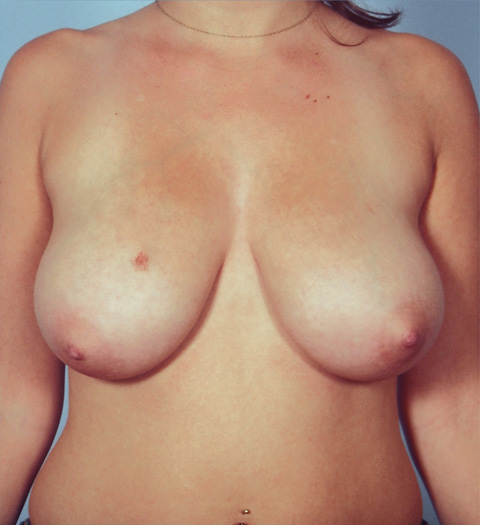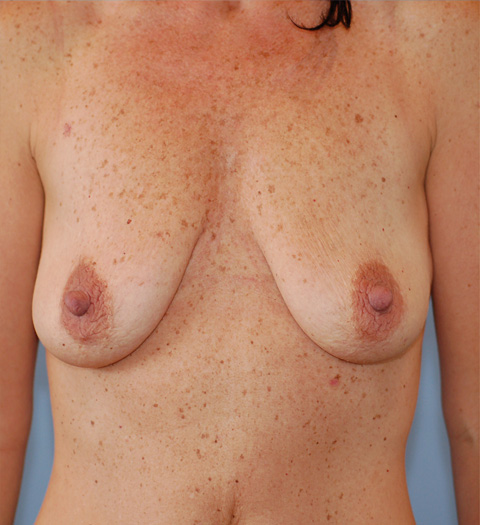Breast Lift
Mastopexy is the surgical term for a breast lift that tightens and reshapes your breast tissue and raises the nipple-areolar to restore a youthful shape. Correcting breast sag or droop involves removal of excess skin with incision lines concealed within the natural breast contours as much as possible. The principles of the operation are very similar to a breast reduction except that volume is usually retained during a breast lift.
A breast lift by itself will not increase your cup size and cannot produce the same upper fullness or ‘perkiness’ that breast implants provide. It is possible to combine a breast lift with placement of implants to achieve a fuller shape, but this is longer and more complex surgery.
- Read on
- Talk to us about Breast Lifts
-
Where are you starting from?
- Skin quality:


Firm elastic skin without stretch marks will respond well to short scar techniques and maintain better shape over time. Younger women who have not had children will generally have better skin quality and firmer tissues.
As time goes by our tissue quality softens and there is more severe pre-existing droop of breast tissues. Pregnancy and weight loss will exaggerate these changes.
Women with a lot of loose skin and stretchmarks will usually require longer incision lines. The poor tissue quality in these cases means that some of the droop may return over time. -
How will they look?
There are many factors that influence how your breasts will look afterwards.
You - The most important of these is what you are starting with (see above) – in other words your age and your anatomy. The severity of breast droop and the quality of your tissues influence both the surgical technique and the result that can be achieved. Even your breasts can be different on each side and the shape of your rib cage can be uneven. Surgical planning starts on the basis of your own dimensions so that it suits your figure.
It is advisable to reach as close to your ideal goal weight as possible before surgery. Weight loss afterwards can influence the shape of the long-term result. Patients with a body mass index below 30 reduce their surgical and anaesthetic risks. Smoking increases the risk of problems with wound healing and infection. All patients are advised to quit smoking before surgery, as many weeks ahead as possible.
Surgical technique will be critical to achieving the best shape, and will be tailored according to your breast size, nipple position and how much tissue is available. Your own breast tissues are reshaped to provide more fullness and projection. If there is pre-existing unevenness or breast scarring the techniques may need adjustment.
In breast surgery there is an art as well as a science involved in pursuit of the optimal result. Dr Januszkiewicz has more than 25 years of experience and will help guide you through this process.
Go to our gallery to see examples of different breast lift surgery -
What's possible, what's not?
The more severe the degree of droop the more surgery is necessary to correct this. In other words, longer incision lines and more adjustment to the internal breast tissues to try and hold them up against gravity. A breast lift cannot provide the same upper breast fullness that implant surgery can. It is possible to combine breast lift and implants at the same surgery in some cases.
A breast lift will elevate the nipple and reshape the breast restoring some fullness and projection. It can improve your figure and lead to a better self-image or self confidence. However, as with any surgery, breast lift has risks and possible complications. It is important to understand these fully. You will need to decide if the surgery can achieve your goals and if the risks and possible complications are acceptable to you. We will discuss all of this with you and answer any further questions you have.
Breast lift cannot be guaranteed to last a lifetime however the results can be very long lasting. Over time your breasts will change and pregnancy, weight changes, menopause and ageing will all influence the results of your surgery. -
On the day
Please read your pre-operative instructions carefully as they contain important information about preparing for your surgery.
You will be asked to arrive for admission to the surgery centre at a time that allows the nursing staff to prepare you for surgery. Your family member or support person is encouraged to be with you at this stage. You will have time to discuss any last minute concerns with Dr Januszkiewicz before he draws the pre-surgical markings on you. The specialist doctor giving your anesthetic will also meet with you beforehand for a thorough discussion. -
After your procedure
After the surgery is complete you will wake up in our recovery area. Once you are more fully awake you should be able to sit up in a comfortable chair and have something to eat and drink. Once Dr Januszkiewicz and the nursing staff are happy that you are ready to be discharged a friend or family member can take you home. It is a good idea to have them bring a pillow so that you can use this under your seatbelt for comfort during the drive home. If your surgery has been done at another hospital and planned with an overnight stay you will usually be ready for discharge before 10am the next morning. If surgical drains are necessary they will usually be removed one or two days after surgery.
For patients who live out of town we can recommend and help pre-arrange hotel or motel accommodation nearby. You must have a friend or family member stay with you for the first night.
Your breasts will be sore afterwards but the pain medication that has been prescribed will help and most women will report that the experience was easier than they expected.
We will see you again for a brief check in the first week after surgery and then usually once more around five weeks later. It usually take six weeks or so for the surgical swelling to settle and your breasts will still be softening gradually over the first 3 months after surgery.
